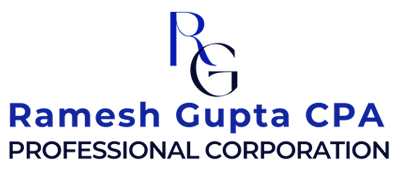Ramesh Gupta CPA Professional Corporation - Our Blog
We are pleased to provide a variety of resources on accounting, taxation and other related subjects that we hope will be helpful to both individuals and businesses.
If you have any questions, simply contact us by email . We will be happy to meet with you for a free, no-obligation consultation.Disclaimer:
The content provided in this blog is for general informational purposes only and is not intended as professional accounting, tax, or financial advice. While efforts are made to ensure the accuracy and timeliness of the content, errors or omissions may occur. The content does not constitute a client-advisor relationship. Readers should consult with a Chartered Professional Accountants or other financial professional for advice tailored to their specific needs. We are not liable for any actions one might take based on the information provided in this blog.
How to Save Information to File Your Income Taxes
In Canada, organizing your information for income tax filing is crucial to ensuring accuracy and maximizing deductions. Here’s the best way to save and manage your tax-related documents:
1. Go Digital for Organization
- Cloud Storage: Use Google Drive, Dropbox, OneDrive, or a secure tax software with cloud backup.
- Tax Software: Our office will store your previous returns and supporting documents, but if you do your own taxes, most software providers will store it for you from year to year.
- PDF Scanning Apps: Use apps like Adobe Scan, Microsoft Lens to digitize paper receipts and tax slips.
2. Categorize Your Tax Documents
These are partial lists. Consult our office for more information
Income Documents:
- T4 – Employment income
- T5 – Investment income
- T4A – Pension, annuities, or self-employment income
- T3 – Trust income
- T4E – Employment Insurance (EI) benefits
- T2202 – Tuition & education credits
Deductions & Credits:
- RRSP Contributions – Receipts for Registered Retirement Savings Plan (RRSP) deposits
- Medical Expenses – Prescription receipts, dental bills, therapy costs
- Charitable Donations – Official donation tax receipts
- Child Care Expenses – Daycare, babysitting, and camp receipts
- Student Loan Interest – T2202 form or loan statements
- Union/Professional Dues – Association fees or union dues
Business or Self-Employed Income:
- Invoices & Receipts – Revenue records
- Business Expenses – Office supplies, advertising, utilities, vehicle expenses (keep a mileage log)
- Home Office Expenses – Rent, utilities, and internet (if you work from home)
- GST/HST Reports – If you are registered for GST/HST
3. Use a Tax Checklist
Click here to access a Tax Checklist as well as a Tax Organizer, Budget Calculator and Budget Worksheet to ensure you don’t miss anything. Keeping a checklist on your cloud storage or in a digital note.
4. Register for CRA Online Account
Sign up for the CRA My Account to access tax slips, track refunds, and check balances.
5. Set Up Auto-Sync for Bank Statements
If you claim investment income, deductions, or self-employment expenses, download bank and credit card statements monthly and keep them in a separate tax folder.
6. Backup Everything
Ensure you back up your tax files to:
- A USB Drive or External Hard Drive (for offline access)
- Encrypted Cloud Storage for security
Contact our office to make your tax filing season as stress free as possible. We are here to help you.
When you subscribe to the blog, we will send you an e-mail when there are new updates on the site so you wouldn't miss them.


Comments